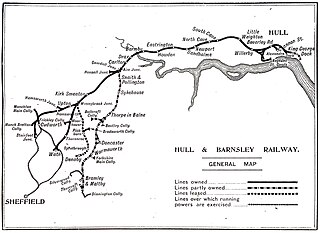
The Tottenham & Hampstead Junction Railway was a railway line in north London, formed by an act of Parliament, the Tottenham and Hampstead Junction Railway Act 1862, of 28 July 1862, which today is mostly part of the Gospel Oak to Barking line. It was effectively part of an attempt by the Great Eastern Railway to obtain a west end terminus to complement Bishopsgate railway station in east London.

The Cheshire Lines Committee (CLC) was formed in the 1860s and became the second-largest joint railway in Great Britain. The committee, which was often styled the Cheshire Lines Railway, operated 143 miles (230 km) of track in the then counties of Lancashire and Cheshire. The railway did not become part of the Big Four during the implementation of the 1923 grouping, surviving independently with its own management until the railways were nationalised at the beginning of 1948. The railway served Liverpool, Manchester, Stockport, Warrington, Widnes, Northwich, Winsford, Knutsford, Chester and Southport with connections to many other railways.

The Hull Barnsley & West Riding Junction Railway and Dock Company (HB&WRJR&DCo.) was opened on 20 July 1885. It had a total projected length of 66 miles but never reached Barnsley, stopping a few miles short at Stairfoot. The name was changed to The Hull and Barnsley Railway (H&BR) in 1905. Its Alexandra Dock in Hull opened 16 July 1885.
The South Yorkshire Railway was a railway company with lines in the West Riding of Yorkshire, England.

The South Yorkshire Junction Railway was a railway which ran from Wrangbrook Junction on the main line of the Hull and Barnsley Railway to near Denaby Main Colliery Village, South Yorkshire. It was nominally an independent company sponsored by the Denaby and Cadeby Colliery Company but was worked by the Hull and Barnsley Railway.

The Barnsley Coal Railway was a short railway which, when fully opened, ran between Stairfoot Junction, on the Mexborough to Barnsley line of the South Yorkshire Railway (SYR) and a triangular junction at Nostell on the line of the West Riding and Grimsby Railway (WR&GR).
Public Health Act is a stock short title used in the United Kingdom for legislation relating to public health.





